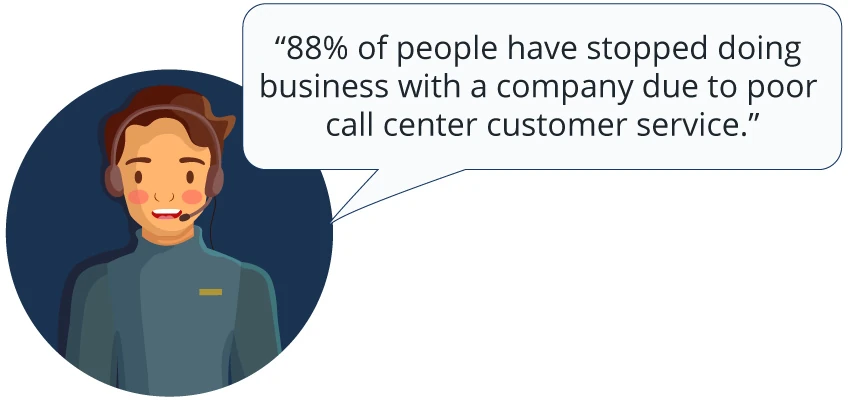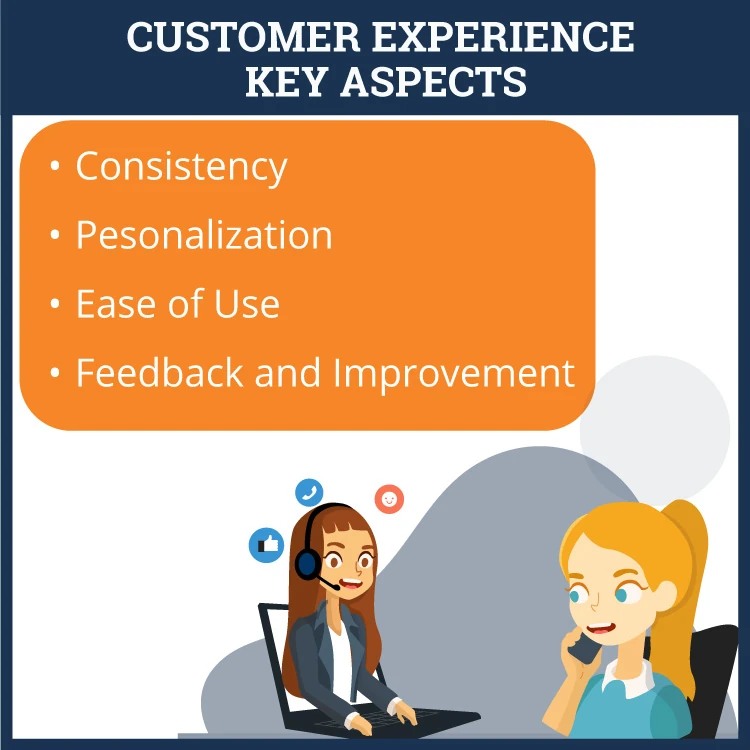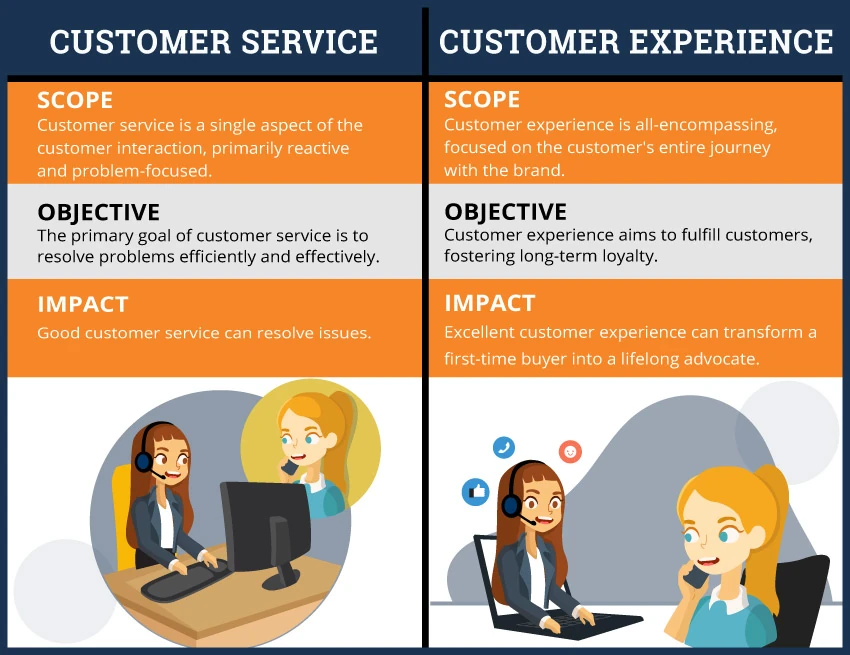The terms ‘Customer Service’ and ‘Customer Experience’ are often used interchangeably in customer support. Customer service and customer experience are closely related but different.
Customer service is about helping customers with their immediate needs, while customer experience covers every interaction a customer has with your company from start to finish. Understanding and combining both can greatly improve your company’s reputation and customer satisfaction.
What is Customer Service?
Customer service in call centers revolves around the support offered to customers before, during, and after purchasing products or services. This encompasses a range of activities, from answering customer inquiries, resolving issues, and providing technical support to handling returns.
Effective customer service is often judged by the speed, efficiency, and courtesy extended by agents. It is primarily reactive, focusing on customer-initiated contact and addressing specific problems or questions that arise.
SQM research shows that 88% of people have stopped doing business with a company due to poor call center customer service. This statistic alone should motivate companies to train their agents in customer service skills.

Why is Customer Service Important for Customer Relationships?
Strong customer service is fundamental to building lasting relationships with customers. It provides a critical touchpoint that can significantly influence customer loyalty and satisfaction. By efficiently resolving issues and demonstrating genuine care and empathy, call centers can make a meaningful impact on how customers perceive their brand. Here are some key aspects:

- Responsiveness: The speed and efficiency with which customer inquiries and issues are addressed. Quick response times and timely resolutions are crucial for maintaining customer satisfaction.
- Professionalism: The manner in which agents interact with customers. This includes being courteous, respectful, and maintaining a positive demeanor throughout the interaction.
- Knowledgeability: The ability of agents to provide accurate and helpful information. This requires thorough training and a deep understanding of the company’s products, services, and policies.
- Empathy: The ability to understand and share the customer's feelings. Demonstrating empathy helps build rapport and trust, making customers feel valued and understood.
These elements help build trust and confidence in the brand, encouraging customer retention and fostering a positive reputation.
What are the Key Metrics for Customer Service?
1. First Call Resolution (FCR)
FCR measures the percentage of customer issues resolved on the first contact. A higher FCR indicates efficient problem-solving and reduces the need for follow-up interactions. SQM's CX research shows that 93% of customers expect their call to be resolved on the first call.
Measuring First-Call Resolution (FCR) can be complex. SQM’s Customer Service QA software uses internal (e.g., case management/CRM) and external (e.g., post-call surveys) methods to calculate the FCR rate.
Request a mySQM™ Customer Service QA Demo Video
Learn about SQM's agent… CSAT prediction model, which is based on standardized metrics, AI, and regression analysis to predict customer satisfaction derived from a QA evaluation. Our CSAT prediction model provides a high statistical correlation, translating to a 95% success rate in predicting agent CSAT in most cases.
2. Average Handle Time (AHT)
AHT is the average duration of a customer service interaction, including talk time, hold time, and any follow-up work. Lower AHT can indicate efficient service, but it must be balanced with quality. SQM Group’s research shows that the number one thing customers expect from call centers is fast resolution for resolving their inquiries or problems.
3. Customer Satisfaction Score (Csat)
Csat is a metric derived from customer surveys that ask customers to rate their satisfaction with the service they receive. It is typically measured on a scale of 1 to 5 or 1 to 10.
4. Net Promoter Score (NPS)
NPS gauges customer loyalty by asking customers how likely they are to recommend the company to others. Responses are on a scale from 0 to 10, with scores categorized into promoters, passives, and detractors.
5. Average Response Time
Average response time is the average time it takes for an agent to respond to a customer inquiry. Faster response times generally correlate with higher customer satisfaction.
What is Customer Experience?
Customer experience in call centers extends beyond simple service interactions to the overall perception customers form based on their cumulative interactions with the brand. It considers the entire lifecycle of the customer, aiming to create a seamless, positive journey from start to finish.
This holistic approach includes everything from finding the correct contact information to how well the call center integrates with the rest of the company’s offerings.
What is the Impact of Customer Experience on Customer Relationships?
The impact of a well-designed customer experience strategy on long-term relationships cannot be overstated. It serves as a differentiator in a competitive market and can be the deciding factor in customer loyalty.
A positive experience can lead to repeat business and referrals, which are crucial for growth and sustainability. On the other hand, a negative experience can cause lasting damage to a brand’s reputation and result in lost customers. Key factors include:

- Consistency: Ensuring that customers have a seamless and uniform experience across all touchpoints, whether in-store, online, or over the phone. Consistency builds trust and reliability.
- Personalization: Tailoring the customer experience to individual needs and preferences. This can include personalized recommendations, offers, and communications that make customers feel unique and valued.
- Ease of Use: The simplicity and intuitiveness of navigating the company's products, services, and platforms. A user-friendly design and clear processes enhance the overall experience.
- Feedback and Improvement: Actively seek and utilize customer feedback to continuously improve the customer experience. This shows customers that their opinions matter and helps refine services to better meet their needs.
These practices ensure that customers feel valued throughout their relationship with the company, turning average interactions into memorable experiences.
What are the Key Metrics for Customer Experience?
1. Customer Effort Score (CES)
CES measures how easy it is for customers to interact with the company and resolve their issues. Lower scores indicate that customers find it easy to get the help they need.
2. Customer Lifetime Value (CLV)
CLV estimates the total revenue a company can expect from a single customer over the course of their relationship. Higher CLV indicates that customers are engaged and loyal.
3. Churn Rate
The churn rate is the percentage of customers who stop using a company’s products or services within a given period. A lower churn rate indicates better customer retention and satisfaction.
4. Customer Feedback and Reviews
Qualitative data is collected from customers about their experiences, often through surveys, online reviews, and social media comments. Positive feedback and reviews indicate a good customer experience.
5. Repeat Purchase Rate
The repeat purchase rate is the percentage of customers who make multiple purchases over time. A higher repeat purchase rate indicates that customers are satisfied and value the overall experience.
What is the Difference Between Customer Service and Customer Experience?
Understanding the distinction between customer service and customer experience can be confusing. While customer service focuses on addressing specific customer needs and issues, customer experience encompasses a broader overview of the customer's journey and overall brand satisfaction.
Here are the main differences:

- Scope: Customer service is a single aspect of the customer interaction, primarily reactive and problem-focused. In contrast, customer experience is all-encompassing, focused on the customer's entire journey with the brand.
- Objective: The primary goal of customer service is to resolve problems efficiently and effectively, whereas customer experience aims to fulfill customers, fostering long-term loyalty.
- Impact: Good customer service can resolve issues, but excellent customer experience can transform a first-time buyer into a lifelong advocate.
For example, imagine you call your internet service provider for help with a connectivity issue:
Customer Service: The agent answers your call quickly, listens to your problem, and provides a clear, step-by-step solution to fix your internet. They are polite and knowledgeable and resolve your issue on the first call.
Customer Experience: When you call, the company's automated system recognizes your number and greets you by name. You have the option to request a callback instead of waiting on hold. After the call, you receive a follow-up email with additional resources related to your issue and a survey to rate your satisfaction. The company also uses your feedback to improve its service.
In this scenario, the agent's effective and courteous assistance is an example of good customer service. The overall smooth, personalized, and considerate process from start to finish showcases a positive customer experience.
By distinctly addressing both customer service and experience, call centers can significantly enhance their overall effectiveness in fostering lasting customer loyalty and satisfaction.
Which One is Better: Customer Service or Customer Experience?
Customer service and customer experience are not mutually exclusive; instead, they work hand in hand to create a holistic and impactful relationship between a business and its customers.
Customer service focuses on addressing immediate needs and concerns, providing quick resolutions, and ensuring customer satisfaction on a transactional level.
On the other hand, customer experience takes a broader view, encompassing every touchpoint and interaction a customer has with the company throughout their entire journey. This includes pre-purchase interactions, the buying process, post-purchase follow-ups, and ongoing engagement efforts.
While customer service is essential for addressing specific issues promptly and effectively, customer experience aims to create a seamless, personalized, and memorable journey that fosters loyalty, advocacy, and long-term relationships.
Ultimately, both customer service and customer experience are crucial elements of a successful business strategy, each contributing unique benefits that collectively enhance the overall customer relationship.
